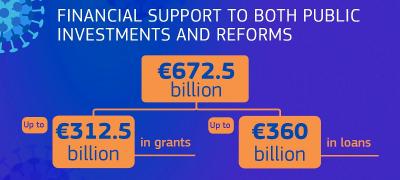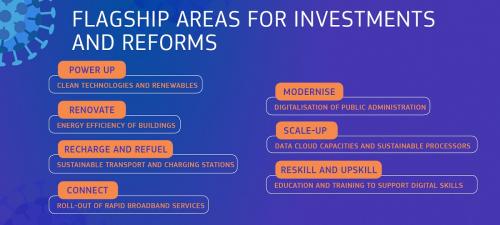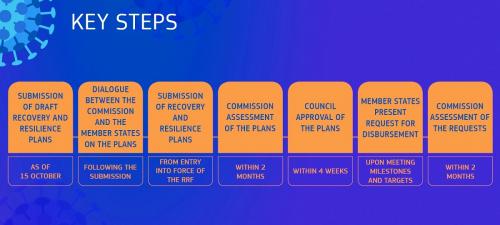EU's recovery fund and the plan to rebuild Europe

ROME - Over the past year, the Coronavirus pandemic has accustomed us to previously unknown phrases and terms in daily conversation. Among these, ‘recovery plan’, ‘recovery fund’ and the like. In current Italian politics, these phrases are linked to controversies for and against the Italian government over alleged delays in submitting the Italian post-covid reconstruction plan to the European Commission. As, however, these delays do not appear to be effective at the moment, it is useful to look at the state of the art.
The Recovery and Resilience Facility
The Facility is a central pillar of NextGenerationEU. The Commission proposed NextGenerationEU as an emergency temporary recovery instrument to help repair the immediate economic and social damage brought about by the pandemic, support an economic recovery and build a better future for the next generation. Together with the EU’s next long-term budget for 2021- 2027, it would bring the total financial support channeled through the EU budget at over €1.8 trillion. The Recovery and Resilience Facility will give 672.5 billion euros in loans and grants available to support reforms and investments undertaken by Member States. The aim is to mitigate the economic and social impact of the current pandemic and make European economies and societies more sustainable, resilient and better prepared for the challenges and opportunities of the green and digital transitions. By offering large-scale financial support for investment and reforms, the Facility will better prepare Member States for a sustainable recovery.
The European Parliament and the Council reached a political agreement in December 2020. On 1 January 2021 the EU’s 1.8 trillion euro recovery budget entered into force. In addition to the EU’s seven-year budget for 2021-2027 the package includes an unprecedented recovery fund, NextGenerationEU. The centrepiece of NextGenerationEU is the mentioned Recovery and Resilience Facility (RRF), a mix of grants and loans – each Member State has access to a pre-defined envelope. It must allocate at least 37% of funding to climate-related spending. And it must also “do no significant harm” to the objectives of the EU Green Deal. To access RRF funding, each Member State must publish a Recovery and Resilience Plan (RRP) that specifies how they plan to spend the recovery money. So far, 11 Member States have submitted draft plans to the Commission while several others have submitted a large number of components.
The Commission has received draft plans from Portugal, Greece, Slovenia, Hungary, Bulgaria, Spain, Germany, Croatia, Czechia, France, Slovakia. The European Commission is currently engaged in discussions with these Member States on the details of their plans, to ensure they meet both the criteria in the draft RRF regulation and the Commission guidance published in September. The deadline for the submission of official drafts is 30 April 2021.The Commission guidance identifies renewable energy as a priority for the RRPs. It lists seven flagship areas where Member States are “strongly encouraged” to direct investment. The Power Up flagship aims to build and integrate 200 GW of additional renewable energy capacity by 2030. It also targets the installation of 6 GW of electrolyser capacity and the production and transportation of 1 million tons of renewable hydrogen across the EU by 2025.
In addition to the RRF there are other EU programmes that are partially frontloaded under NextGenerationEU, including: the 17.5 billion euro Just Transition Fund, which will help regions transition away from fossil fuels; the 26 billion euro InvestEU programme, which will provide guarantees for loans from the European Investment Bank and other public investment banks to de-risk investments in areas such as sustainable infrastructure; and Horizon Europe, the EU’s 96 billion euro research and innovation programme. Elements of some of these programmes have yet to be finalised.
The Facility and NextGenerationEU
The Commission proposed the Facility on 27 May 2020 as the centrepiece of NextGenerationEU , a temporary recovery instrument that allows the Commission to raise funds to help repair the immediate economic and social damage brought about by the pandemic. The Facility is also closely aligned with the Commission’s priorities ensuring in the long-term a sustainable and inclusive recovery that promotes the green and digital transitions. On July 21, 2020, the European Council reached a political agreement on NextGenerationEU, including the Facility, and the 2021-2027 long-term EU budget. Member States will prepare recovery and resilience plans that set out a coherent package of reforms and public investment projects. To benefit from the support of the Facility, these reforms and investments should be implemented by 2026.
The European Semester and the Recovery and Resilience Facility are intrinsically linked. The publication of the 2021 Annual Sustainable Growth Strategy launched this year’s European Semester. It continues last year’s growth strategy based on the European Green Deal and the concept of competitive sustainability. The Commission is due to assess recovery and resilience plans against the country-specific recommendations. As the European Semester and the Facility will overlap, it is necessary to temporarily adapt the European Semester.
Each recovery and resilience plan will have to include a minimum of 20% of expenditure to foster the digital transition. The Commission is developing a methodology to ensure investment is channeled to both infrastructure and digital capacities.
The Recovery and Resilience Task Force (RECOVER) was established on 16 August 2020 within the European Commission’s Secretariat-General. RECOVER is responsible for steering the implementation of the Recovery and Resilience Facility and for coordinating the European Semester, in close cooperation with the Commission’s Directorate-General for Economic and Financial Affairs. RECOVER reports to Commission President Ursula von der Leyen.
Sharing the sum
· The Recovery and Resilience Facility will provide up to €672.5 billion to support investments and reforms (in 2018 prices).
· This breaks down into grants worth a total of €312.5 billion and €360 billion in loans.
· For 70 per cent of the total of 312.5 billion euros available in grants (in 2018 prices), the allocation key will take into account:
• the Member State’s population,
• the inverse of its GDP per capita
• its average unemployment rate over the past five years (2015-2019) compared to the EU average.
· For the remaining 30 per cent, instead of the unemployment rate, the observed loss in real GDP over 2020 and the observed cumulative loss in real GDP over the period 2020-2021 will be considered.
· While Annex I of the Regulation provides an indicative amount for the 30 per cent in current prices on the basis of the Autumn forecast, this remains an estimate and will only be finalised when Eurostat presents final data in June 2022.
· Member States can request a loan worth up to 6.8 per cent of their 2019 GNI as part of the submission of their recovery and resilience plan.
Italy’s plan
Italy is set to receive, with Spain, the largest share: 209 billion euros, or 28 percent of the entire rescue fund. Italian Prime Minister Giuseppe Conte described the funding as “an opportunity to build a better Italy” and said he doesn’t want to “waste a single euro.” As well as using the English phrase ‘Recovery Fund’, in Italian it is also referred to as the ‘Piano nazionale di resilienza e rilancio’, or National Resilience and Relaunch Plan (PNRR). The draft of the Italian Recovery Plan arrived in Brussels informally a few days ago, the Economy Commissioner Paolo Gentiloni made it known that Italy’s plan still needs some strengthening. The Commissioner said that February and March will be key months for the consolidation of the plan and each country will announce how it intends to spend its share of the overall 750 billion Recovery Fund, which will be validated by the EU finance ministers. “At the end of this process, the country receives 13 per cent of the plan it presented,” Gentiloni told Reuters. “This means that in late spring, the Commission will go to the financial markets to raise this money ... with the aim of providing pre-financing of this 13 per cent to each country with an approved plan.”
NexGenerationEU breakdown
Recovery and resilience Facility (RRF): €672.5 billion
of which, loans: €360 billion
of which, grants: €312.5 billion
ReactEU: €47.5 billion
Horizon Europe: €5 billion
InvestEU: € 5.6 billion
Rural Development: €7.5 billion
Just Transition Funds (JTF): €10 billion
RescEU: €1,90 billion
Total: €750 billion
gn ol




